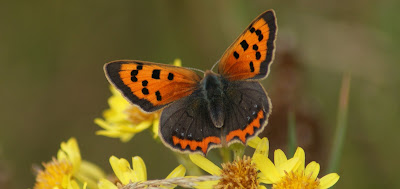Last night I joined Andy & Melissa Banthorpe, who were running 3 lights in the southern half of Maulden Woods. Any people with
mottephobia - a real fear of moths - just wouldn't have coped, because there were so many flying around, let alone those settled on the sheet or in the traps. They were landing in our hair, fluttering in our ears....and I even managed to swallow a few! But what a fantastic evening as one species after another made an appearance.
Andy & Melissa reckon that it will beat their previous best ever night, when they managed a haul of some 123 separate species! My favourite was the Pine Hawkmoth - my 9th Hawkmoth species, but there were plenty of others with that special something, too: the wonderful green hue of the Large Emerald, for instance, or some of the tiny bright golden micros! And then there was the strange Leopard Moth that suddenly appeared and took our breath away. I took him home to get a photo.....

...only to find two in my own back garden moth-trap!!
What a fantastic creature! Mind you, so is a Bullfinch and, like a Bullfinch, the Leopard Moth is not appreciated by people who like their fruit trees, because the larvae of this moth will spend a few years chomping its way down the middle of an apple or pear branch, both weakening it and making it more susceptible to disease.
But we haven't got any fruit trees in our garden, and these beauties are welcome to pop by anytime!
UPDATE: 159 moths confirmed from Maulden Wood so far, with 5 yet to be identified (I was fortunate to see most of these)!!! The list looks something like this:
16 Gold Swift 1
130 Incurvaria masculella 1
161 Leopard Moth 1
246 Tinea semifulvella 1
410 Argyresthia brockeella 1
411 Argyresthia goedartella 1
415 Argyresthia retinella 1
417 Argyresthia spinosella 1
420 Argyresthia pruniella 1
424 Yponomeuta evonymella 2
442 Cedestis gysseleniella 1
462 Ypsolopha sequella 2
464 Diamond-back Moth 5
640 Batia lunaris 1
642 Batia unitella 2
658 Carcina quercana 2
688 Agonopterix heracliana 1
756 Parachronistis albiceps 1
765 Teleiodes vulgella 1
774 Teleiodes luculella 1
874 Blastobasis lacticolella 1
925 Phtheochroa rugosana 1
946 Aethes rubigana 1
966 Cochylis atricapitana 2
970 Pandemis cerasana 2
972 Pandemis heperana 1
977 Archips podana 1
980 Archips xylosteana 1
987 Ptycholomoides aeriferanus 1
1001 Lozotaenoides formosanus 10
1010 Ditula angustiorana 1
1032 Aleimma loeflingiana 20
1036 Acleris forsskaleana 1
1076 Celypha lacunana 1
1082 Hedya pruniana 1
1083 Hedya nubiferana 1
1169 Gypsonoma dealbana 1
1175 Epiblema uddmanniana 5
1200 Eucosma hohenwartiana 1
1201 Eucosma cana 5
1205 Spilonota ocellana 1
1211 Rhyacionia pinicolana 5
1272 Pammene aurana 2
1293 Chrysoteuchia culmella 10
1334 Scoparia Ambigualis 10
1345 Brown China-mark 5
1376 Small Magpie 5
1377 Perinephela lancealis 1
1390 Udea prunalis 1
1392 Udea olivalis 2
1405 Mother of Pearl 10
1413 Gold Triangle 2
1428 Bee Moth 1
1436 Conobathra repandana 2
1495 Marasmarcha lunadactyla 1
1513 White Plume Moth 1
1640 The Drinker 1
1647 Barred Hook-tip 1
1648 Pebble Hook-tip 1
1652 Peach Blossom 25
1653 Buff Arches 30
1655 Poplar Lutestring 1
1657 Common Lutestring 4
1666 Large Emerald 5
1667 Blotched Emerald 1
1669 Common Emerald 10
1681 Clay Triple-lines 30
1682 Blood-vein 2
1702 Small Fan-footed Wave 5
1708 Single-dotted Wave 1
1713 Riband Wave 30
1726 Large Twin-spot Carpet 10
1727 Silver-ground Carpet 1
1758 Barred Straw 1
1765 Barred Yellow 2
1768 Grey Pine Carpet 3
1784 Pretty Chalk Carpet 1
1791 Brown Scallop 2
1792 Dark Umber 1
1803 Small Rivulet 2
1811 Slender Pug 1 dissected
1816 Toadflax Pug 1
1819 Mottled Pug 2 dissected
1830 Wormwood Pug 1 dissected
1837 Grey Pug 1 dissected
1856 Larch Pug 2 dissected
1858 V-pug 8
1859 Sloe Pug 2
1860 Green Pug 1
1862 Double-striped Pug 2
1874 Dingy Shell 1
1876 Small Yellow Wave 3
1887 Clouded Border 3
1893 Tawny-barred Angle 20
1902 Brown Silver-line 5
1906 Brimstone Moth 5
1922 Swallow-tailed Moth 1
1931 Peppered Moth 8
1937 Willow Beauty 2
1941 Mottled Beauty 30
1944 Pale Oak Beauty 1
1947 The Engrailed 2
1950 Brindled White-spot 1
1954 Bordered White 5
1955 Common White Wave 5
1956 Common Wave 1
1958 Clouded Silver 3
1961 Light Emerald 5
1962 Barred Red 5
1978 Pine Hawk-moth 1
1991 Elephant Hawk-moth 1
1994 Buff-tip 7
2009 Maple Prominent 25
2030 Yellow-tail 2
2037 Rosy Footman 20
2044 Dingy Footman 5
2047 Scarce Footman 2
2049 Buff Footman 2
2050 Common Footman 1
2061 Buff Ermine 2
2088 Heart & Club 2
2098 The Flame 2
2102 Flame Shoulder 2
2107 Large Yellow Underwing 2
2120 Ingrailed Clay 2
2128 Double Square-spot 5
2150 Grey Arches 4
2155 Dot Moth 1
2160 Bright-line Brown-eye 2
2192 Brown-line Bright-eye 1
2198 Smoky Wainscot 5
2278 Poplar Grey 1
2279 The Sycamore 1
2280 Miller 1
2284 Grey Dagger 1 gen checked on male
2301 Bird's Wing 1
2302 Brown Rustic 5
2305 Small Angle-shades 1
2318 The Dun-bar 1
2319 Lunar-spotted Pinion 1
2321 Dark Arches 5
2326 Clouded-bordered Brindle 1
2330 Dusky Brocade 1
2337 Oligia strigilis agg. 5
2341 Cloaked Minor 1
2349 Mere Wainscot 1
2381 The Uncertain 5
2387 Mottled Rustic 5
2410 Marbled White Spot 10
2423 Oak Nycteoline 4
2425 Nut-tree Tussock 2
2441 Silver Y 1
2442 Beautiful Golden Y 1
2466 The Blackneck 1
2473 Beautiful Hook-tip 3
2474 Straw Dot 3
2477 The Snout 2
2489 Fan-foot 2
2492 Small Fan-foot 5
Wow!!


























